The week at a glance
- American Buff-bellied Pipit in County Antrim
- Pacific Diver still in Cornwall
- Gyrfalcon in Cornwall
Another fairly chilly week passes by and as December tries hard to warm the cold, winter birding heart, it has to be said that it's all a bit of a struggle. Harsh and surprisingly cool southerly winds chilled to the core, while very heavy rain caused flooding across some western parts of the country over the weekend, but better (well, drier) weather was thankfully waiting in the wings.
Northern Ireland's first American Buff-bellied Pipit was found at Mullagh, Lough Beg (Co. Antrim) on 11th and remained to 15th at least. The bird has shown every morning until flushed by other birds, before it disperses with Meadow Pipits. Birders south of the border have enjoyed several records of this distinctive American vagrant in the last 14 months (including the long-staying wintering bird in County Cork) but Province-only birders have had to wait just that little bit longer. Down in Cornwall, the adult Pacific Diver was again showing from time to time in Mounts Bay during the week, but was often distant and, even more often, not seen at all. Elsewhere in west Cornwall, last week's Scilly Gyrfalcon made it to the mainland on 15th, appearing around Sennen and Land's End, where it was seen again on 16th before a brief appearance near Nanquidno on 17th.
As expected now, the adult White-billed Diver on South Ronaldsay (Orkney) made it to another review, the bird still present on 14th. A single Little Auk was seen off Hengistbury Head (Dorset) on 11th and 49 were seen off Sumburgh Head, Mainland (Shetland) on 14th. A Balearic Shearwater was seen from Berry Head (Devon) on 13th, with single Pomarine Skuas seen from Hurst Castle (Hampshire) on 13th and Whitburn (Co. Durham) on 14th.

Night Heron, Hythe, Kent (Photo: Richard Jeffree)
The Cattle Egret at West Angle Bay (Pembrokeshire) was still present from 11th–17th with what was thought to be the same bird some four miles away, at Sandy Bay, on 13th. The bird at Dorchester-on-Thames (Oxfordshire) remained to 17th, and another was at Halsetown (Cornwall) on 16th. In Ireland, the Cattle Egret at Inchydoney (Co. Cork) was still present to 13th. The usual Great White Egret was at Blashford Lakes (Hampshire) on 13th–14th. Two Spoonbills were seen from a cruise off Jupiter Point (Cornwall) on 11th, a single bird was seen again at Cliffe Pools (Kent) on 13th–17th, and four were at Isley Marsh (Devon) on 14th. A lone Spoonbill was on Samson (Scilly) on 15th–16th and three birds were seen at Brownsea Island (Dorset) on 17th. The adult Glossy Ibis moved back to Warton Marsh (Lancashire) on 11th–12th and the adult Night Heron was still to be seen along the Royal Military Canal at Hythe (Kent) on 11th–17th. The two Common Cranes at Eldernell (Cambridgeshire) were last reported on 10th, and a local-bred juvenile was with an adult at Horsey (Norfolk) on 12th.
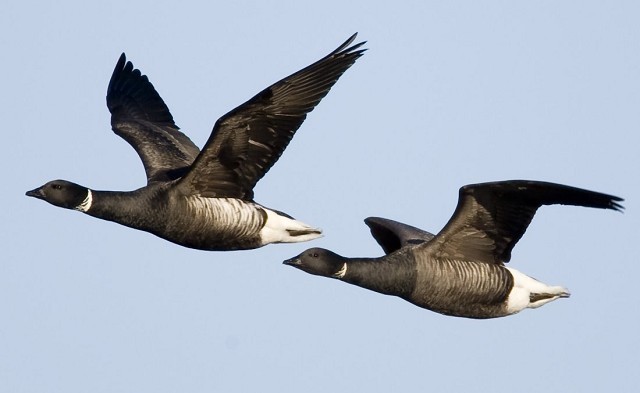
Black Brant, Titchwell RSPB, Norfolk (Photo: John Miller)
In Hampshire, the adult Red-breasted Goose remained around Normandy Marsh throughout the week, while in southern Scotland, the Cackling Canada Goose was once again seen at Caerlaverock (Dumfries & Galloway) on 13th. The adult white-morph Snow Goose remained around Druridge Pools (Northumberland) to 12th before appearing at Linton Lane NR on 14th. In Ireland, a Snow Goose was still present on the North Slob (Co. Wexford). The adult Ross's Goose in east Norfolk was seen early on the morning of 14th, flying over Burgh Castle near Great Yarmouth (and was thought to have been seen at Thorpe Marshes the previous day). What may have been the same bird was reported from Buckenham Marshes (Norfolk) on 17th. On 11th, a Black Brant was seen again at Pagham Harbour (West Sussex) and another was in County Wexford, on the North Slob (with two birds present on 16th). The 12th saw a Black Brant appear at Thorney Island (West Sussex) and in Norfolk the regular bird remained at Titchwell, while along the coast at Holkham two adults were joined by an adult Black Brant x Dark-bellied Brent Goose hybrid on 13th. Also on 13th, the regular adult Brant was again at Gosport (Hampshire), while two more adults were seen at Chickerell (Dorset) on 14th, with what seems likely to be a third bird at Ferrybridge. In Kent, a Black Brant was on the Swale Estuary (Kent), also on 14th.

Lesser Scaup, Hogganfield Loch, Clyde (Photo: William Thom)

Ring-necked Duck, Bordon, Hampshire (Photo: Gavin Farnell)

Ring-necked Duck, Martnaham Loch, Ayrshire (Photo: Jim Woods)
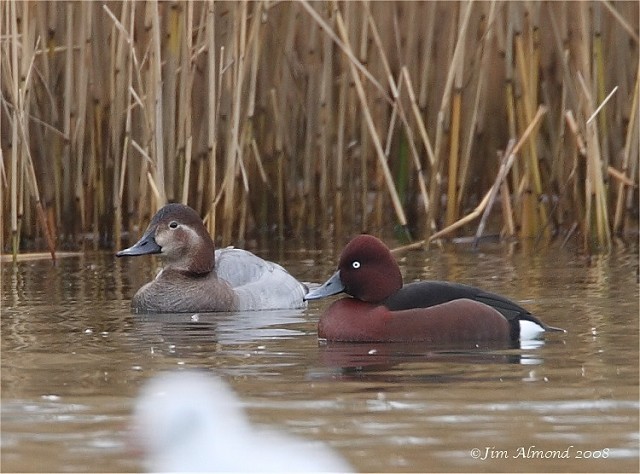
Ferruginous Duck, Cosmeston Lakes CP, Glamorgan (Photo: Jim Almond)
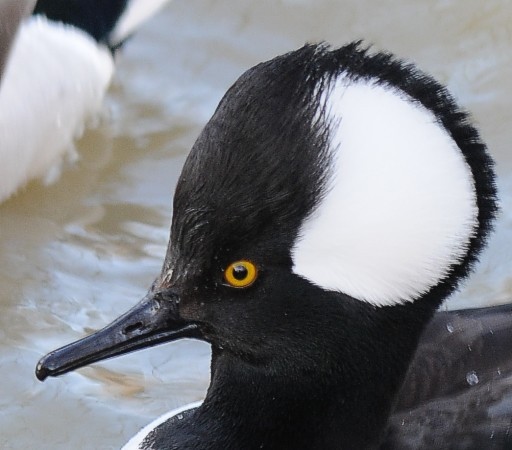
Hooded Merganser, Radipole Lake RSPB, Dorset (Photo: Helen Horrocks)
In Warwickshire, it seemed as if persistence had finally paid off when a first-winter female Lesser Scaup was identified on 12th at Lea Marston & Coton Lakes, having first been seen at the site on 20th November. The bird remained to 17th, by which time the identification was being questioned once more. The adult drake Lesser Scaup was still at Holme Pierrepoint (Nottinghamshire) to 16th, while on Hogganfield Loch (Clyde) the adult drake was still in place to 17th. In Ireland, the female Lesser Scaup was still on Clea Lakes (Co. Down) to 14th. The first-winter drake Ring-necked Duck was still in place near Bordon (Hampshire) from 11th–17th, while two females were seen on The Gearagh (Co. Cork) on 13th and single females were at Martnaham Loch (Ayrshire) to 15th and Swineham GPs (Dorset) to 17th. A female-type Ring-necked Duck was seen flying along the River Eden (Cumbria) on 14th and wintering drakes were still at Foxcote Reservoir (Buckinghamshire) and Loch Bhasapol, Tiree (Argyll) on the same day (the Tiree bird remaining to 17th). In Leicestershire, the first-winter drake Ferruginous Duck reappeared on Groby Pool on 11th (having last been noted there on 17th November) and the drake at Cosmeston Lakes Country Park (Glamorgan) was seen on 12th and 14th. A female Ferruginous Duck (or hybrid) was seen for a short time on Wroxham Broad (Norfolk) on 14th. The drake American Wigeon was seen again at Lower Farm CP (Berkshire) on 13th and 15th–16th, while the long-staying drake was still on Loch Bee, South Uist (Outer Hebrides) on 14th. A drake Green-winged Teal was seen again on the Loch of Tankerness (Orkney) on 11th and was followed by singles at Marshside (Lancashire), also on 11th, and at Kinneil Lagoons (Forth) on 12th. Two drakes were found at Loch Spynie (Moray) on 13th. On 14th, a drake Green-winged Teal was found on the Wyre Estuary (Lancashire) with other single birds remaining on Loch Bee and at the North Slob, and on 15th, another was seen at the Montrose Basin (Angus). The female Surf Scoter continued to enjoy a second winter off Dawlish Warren (Devon) this week and the female on Tiree (Argyll) remained in Hough Bay to 17th. In County Mayo, the first-winter drake King Eider remained off Frenchpoint Pier, Annagh Head to 13th at least and in Dorset, the drake Hooded Merganser was still attracting the insurance-listers to Radipole Lake to 16th at least (although, with the species now on the British List, the BBRC may just give the bird the green light, as identification is beyond doubt and there have been no signs of captive origin — just like any number of pre-Outer Hebrides Hooded Mergansers really — so maybe just fill your boots!)
A juvenile Rough-legged Buzzard flew over Stanhoe (Norfolk) on 11th, while leftover birds from last week (and further back too) remained near Coveney (Cambridgeshire) and Millington (East Yorkshire) on the same date (with two birds present on 17th). Birds were also still at Leighton Moss (Lancashire) and around Farforth (Lincolnshire) on 12th and at Capel Fleet, Isle of Sheppey (Kent) on 14th (the latter two birds still present to 17th). Also on 14th, a further Norfolk individual was seen near Wighton, and in North Yorkshire a Rough-legged Buzzard was seen at Commondale on 15th. On Scilly, the young male Snowy Owl was still being seen on St. Martin's to 6th at least.
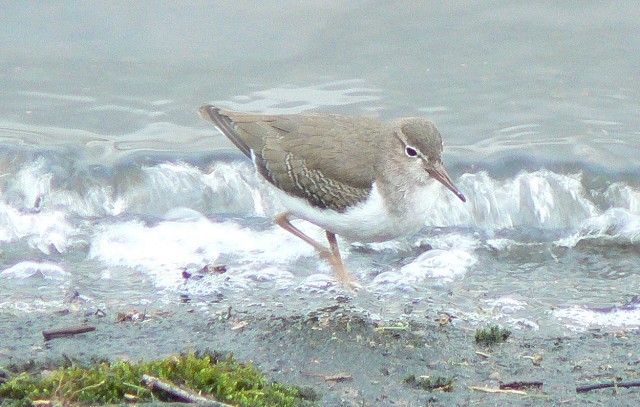
Spotted Sandpiper, Tittesworth Reservoir, Staffordshire (Photo: Danny Foy)
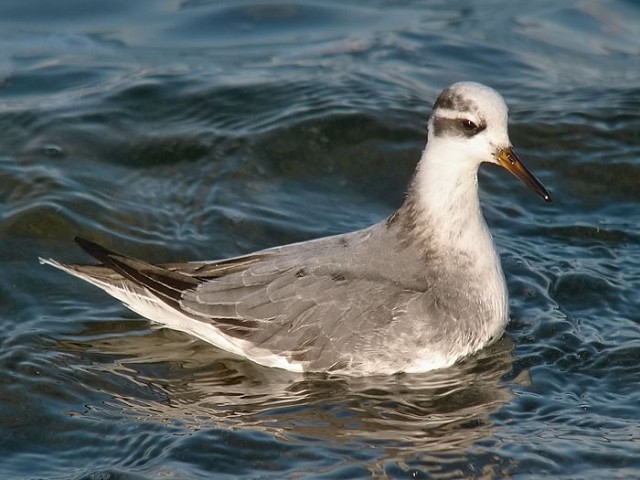
Grey Phalarope, Covenham Reservoir, Lincolnshire (Photo: Russell Hayes)
The first-winter Spotted Sandpiper at Tittesworth Reservoir (Staffordshire) was still present to 17th, while the White-rumped Sandpiper at St. John's Lake (Cornwall) remained to 11th. The Lesser Yellowlegs that makes occasional appearances at Southwold (Suffolk) popped up again on 13th–14th and the Pectoral Sandpiper at Loughbrickisland Lake (Co. Down) was seen again on 11th (having last been noted there on 25th November). Two Long-billed Dowitchers were seen on the 14th: the first-winter was still at North Bay, South Uist (Outer Hebrides) and the adult remained in Dundalk Harbour (Co. Louth). The long-staying Grey Phalarope remained at Covenham Reservoir (Lincolnshire) until 17th.

Ivory Gull, Fetlar, Shetland (Photo: Brydon Thomason)

Iceland Gull, Greencastle, Donegal (Photo: Derek Charles)

Glaucous Gull, Ashington, Northumberland (Photo: Brian Bullough)
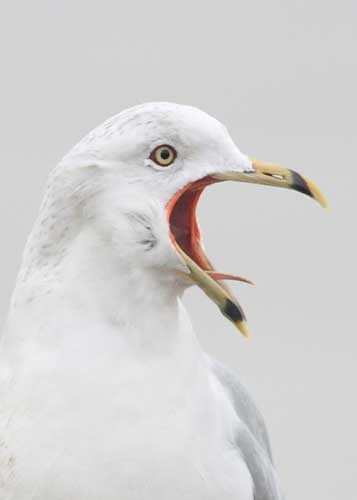
Ring-billed Gull, Westcliff-on-Sea, Essex (Photo: Darren Chapman)
On Shetland, a first-winter Ivory Gull was the undoubted highlight of 14th–15th, spending time on the beach at Oddsta, Fetlar. The finder had been purposely baiting the beach for a month or more, so plainly it was time well spent! It appears from photographs to be slightly different from the young bird seen on mainland Shetland on 21st November. Over in Galway, the adult American Herring Gull remained around Nimmo's Pier and the nearby docks to 13th at least. Once again, this week saw some 30 Caspian Gulls reported around the country, with two birds each for Carsington Water (Derbyshire) on 14th, Chasewater (Staffordshire) and Eyebrook Reservoir (Leicestershire) on 15th and Beddington Sewage Farm (London) on 17th. Mirroring Caspian Gull, the tally of Iceland Gulls this week is very similar to that of last week: around 55 birds were recorded, including seven at the Shetland Catch factory on 14th, three birds at Rossaveal (Co. Galway) on 16th and three more at Mallaig (Highland) on 17th. At least four birds were seen in Ayrshire during the week and two were at Throckmorton Tip (Worcestershire) on 14th. An adult Iceland Gull seen at the Shetland Catch on 13th showed dark outer webs to the two outermost primaries, so may well have been a Kumlien's Gull. Just under 30 Glaucous Gulls were seen this week, with the undoubted star being the colour-ringed youngster at Minsmere (Suffolk) on 12th and 16th, which is now known to have originated from Bear Island, Svalbard, where it was ringed in July this year. The bird was first seen at Minsmere on 4th December. In Cornwall, single first-winter Ring-billed Gulls were at Helston on 11th–13th and at Padstow on 13th (this presumably the bird noted in the roost there on 23rd November) while the first-winter at Six Mile Water (Co. Antrim) was seen again on 15th–17th. The second-winter bird remained at Lamby Lake (Glamorgan) to 17th, while adults this week were seen at West Angle Bay (Pembrokeshire), Gosport (Hampshire), Isle of Dogs (London), Westcliff-on-Sea (Essex), Oban (Argyll), Dundee (Angus), Cobh and Ring (Co. Cork), Sligo and, inevitably, Nimmo's Pier (Co. Galway). Three Ring-billed Gulls, a second-winter and two adults, were at Clonakilty (Co. Cork) on 13th.
A Richard's Pipit was found at Parkgate Old Baths, Neston (Cheshire) on 16th while in Fife a Black-bellied Dipper was seen on Kenly Water, Boarhills on 11th. It was another excellent week for Great Grey Shrike and we start with a late report from last week of a bird at Brechfa (Carmarthenshire) on 10th; this was followed by single birds still at Draycote Water (Warwickshire), Bishop's Dyke in the New Forest (Hampshire), Furneux Pelham (Hertfordshire) and Dalwhinnie (Highland) on 11th, and at Charterhouse (Somerset) on 12th. A new bird was noted at Briantspuddle (Dorset) on 13th. On 14th, a returning Great Grey Shrike was back at Clocaenog Forest (Clwyd), having departed in mid-March, and further birds were seen at Broomy Plain (again in the New Forest), at Swinley Park (Berkshire), near Burton-in-Kendal (Cumbria) and at Glasfynydd Forest (Powys), while two birds were seen in Langdale Forest (North Yorkshire). On 15th, back in Clwyd, a Great Grey Shrike was at Fenn's Moss and the impressive roll-call ends with a bird at Stithians Reservoir (Cornwall) on 17th.

Waxwing, Hereford, Herefordshire (Photo: Kev Joynes)
Although some sizeable flocks of Waxwings were still being encountered this week, there was a distinct feeling that numbers were dropping away fairly rapidly in Scotland, as birds continued to disperse and drift south of the border. Some 210 birds were at Joppa (Lothian) on 11th, 300+ were noted around Ayr (Ayrshire) on 12th, 130 were at Clarkston (Clyde) on 14th and at least 80 birds were around Linlithgow (Lothian), also on 14th. A minimum of 150 Waxwings were still to be seen around Glasgow (Clyde) on 16th (with perhaps as many as 300 around the city), with a further 100 at Drem (Lothian), also on 16th. In northern England, a flock of 95 birds was seen in Leeds (West Yorkshire) on 12th, while 50+ remained around Kirklevington (Cleveland) on the same date, rising to 75 or more on 13th. Also on 13th, at least 60 Waxwings were still being seen around Sheffield (South Yorkshire) and at least 80 were around Stockton-on-Tees (Cleveland) on 17th. In the northwest, Cumbria, Lancashire, Greater Manchester and Cheshire hosted birds this week, with highest counts being 20+ in Blackburn and 41 in Grange-over-Sands on 11th, 35 in Penrith on 12th and 30 at Macclesfield on 14th. Six Midlands counties scored with Waxwings this week, including 50 at Baddeley Green, Stoke-on-Trent (Staffordshire) on 14th and 47 near West Bridgford (Nottinghamshire) on 17th. In East Anglia it was Rendlesham in Suffolk that came out top of the tree, with 24 birds on 11th building to 42 by 14th. A couple of singles were seen in Cambridgeshire and two were at Fingringhoe Wick (Essex) on 11th. In the southeast, two birds were seen at Bexley Woods (London) on 11th, with two more twos at Reculver and also Pegwell Bay (Kent) on the same day. Eight birds were at Botley (Hampshire), also on 11th while three Waxwings were at Lower Halstow (Kent) on 12th. On 16th, a lone Waxwing was seen in East Sussex, at Seaford. A single bird was heard in Taunton (Somerset) on 11th and one made it on to St. Mary's (Scilly) on 14th, the first on the islands since December 2005. In the north of Ireland, 10 birds were in Antrim on 13th while down south, the highest counts were of 20 in Buncrana (Co. Donegal) on 11th, 36 at Loughlinstown (Co. Dublin), also on 11th, and 30 more at Inchicore (Co. Dublin) on 13th. Others were seen in Wicklow and Louth.

Yellow-browed Warbler, Fareham, Hampshire (Photo: Richard Ford)
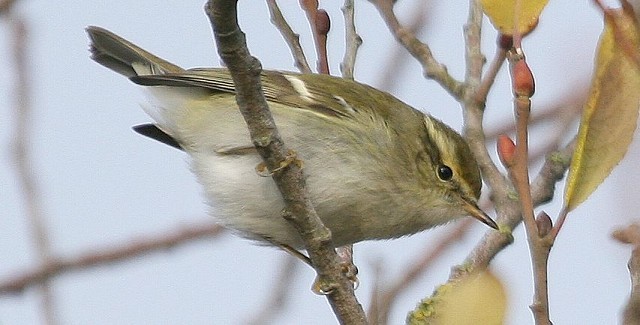
Yellow-browed Warbler, Fareham, Hampshire (Photo: Nick Bond)
A Yellow-browed Warbler was found at Fareham (Hampshire) on 12th, remaining to 17th, by which time it was in song, while Siberian Chiffchaffs this week included single birds at Countess Wear (Devon) and Dungeness (Kent). In Highland, a wintering Lesser Whitethroat remained at Halistra, Waternish Point, Skye to 14th.
The first Two-barred Crossbill for Herefordshire, a female, was seen at Bircher Common on 11th. At the end of October and into early November there were a couple of "possible" and "probable" sightings of a Little Bunting at Old Basing (Hampshire), in reedbeds and woodlands near the local pub. Nothing more was heard of the bird until this week when, on 12th, the bird was reported again in the same general area. Watch this space as the New Year Listers start to hone in on what's what for January 1st.
Photo of the Week

Short-eared Owl, undisclosed site, Lancashire (Photo: David Cookson)
For various reasons, humans have always had an affinity with owls. Images of these birds therefore have a particular appeal. The Barn Owl and Short-eared Owl have proved especially popular as photographic subjects, and we've received around 400 images of each of these species. In fact, we've even had comments debating which of the two species is the more photogenic. With a superb portfolio of images of both these owls, David Cookson makes a good case for calling the contest a tie. In this week's winning image, David has frozen a hunting SEO in glorious low-altitude sunlight, bringing out the luminous golden hues in the bird's richly marked plumage. Great head-turn and facial lighting, strong Rule of Thirds composition and a perfect backdrop round off a supremely aesthetic image.
Other notable photos

Little Owl, undisclosed site, Lancashire (Photo: Tom Charles)

Bittern, undisclosed site, Northumberland (Photo: D Johnson.)

Waxwing, Macclesfield, Cheshire (Photo: Mike Atkinson)

Curlew, undisclosed site, Lancashire (Photo: David Cookson)

Reed Bunting, Shillito Wood, Derbyshire (Photo: Robert Askew)

Hooded Merganser, Radipole Lake RSPB, Dorset (Photo: John Dickenson)

Smew, Far Ings NR, Lincolnshire (Photo: Dean Eades)
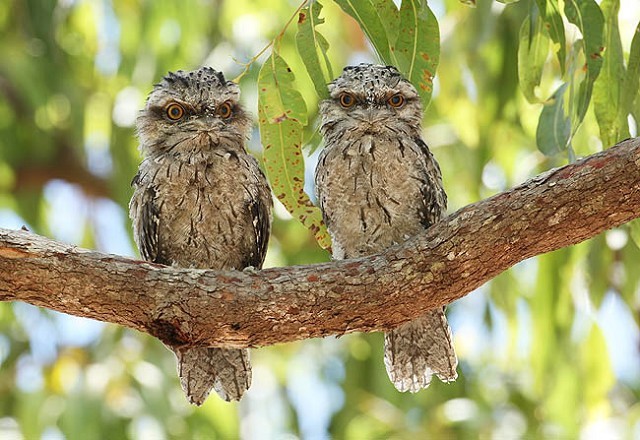
Tawny Frogmouth, Australia (Photo: Steve Arlow)

Glaucous Gull, Salthouse, Norfolk (Photo: Amanda Hayes)

Glossy Ibis, Spain (Photo: Steve Fletcher)

Common Redshank, Little Milford, Pembrokeshire (Photo: Richard Steel)

Black-winged Stilt, Spain (Photo: C.David Elliott-binns)
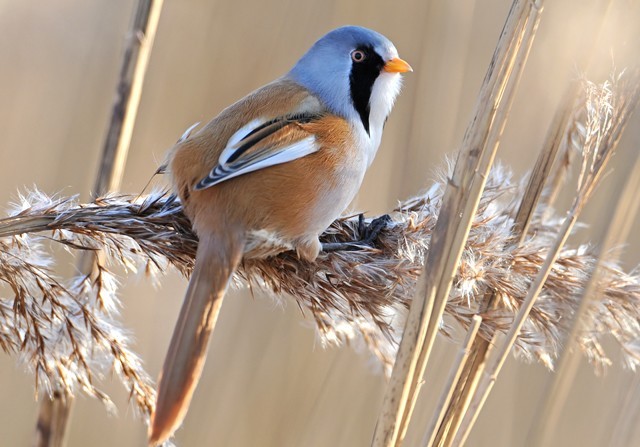
Bearded Tit, Cosmeston Lakes CP, Glamorgan (Photo: Kev Joynes)

Common Treecreeper, Forest of Dean, Gloucestershire (Photo: Gary Thoburn)

Mistle Thrush, Wyre Forest, Worcestershire (Photo: John Robinson)

Pink-footed Goose, Marshside RSPB, Lancashire (Photo: Marcus Conway)

